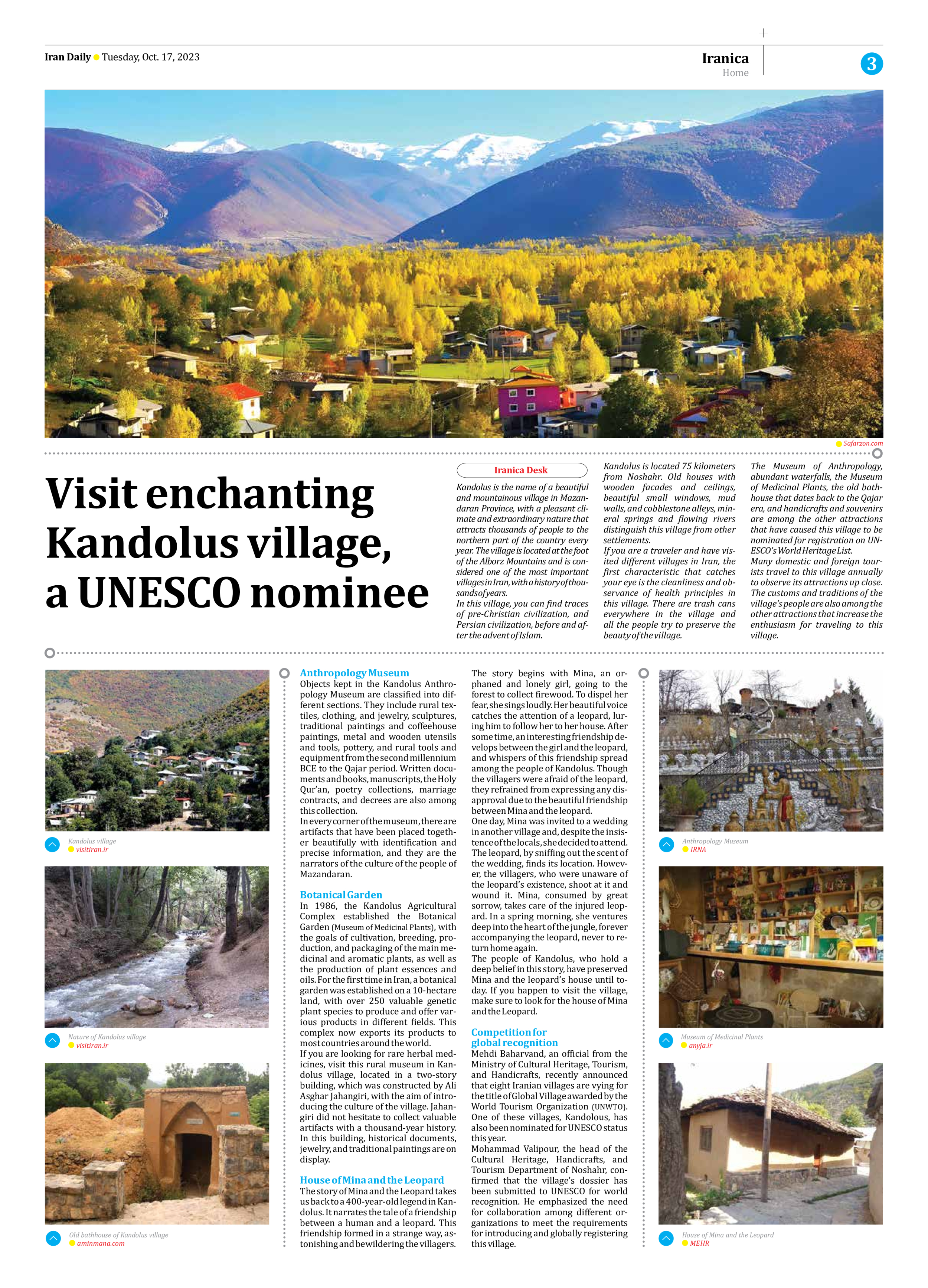
Visit enchanting Kandolus village, a UNESCO nominee
Kandolus is the name of a beautiful and mountainous village in Mazandaran Province, with a pleasant climate and extraordinary nature that attracts thousands of people to the northern part of the country every year. The village is located at the foot of the Alborz Mountains and is considered one of the most important villages in Iran, with a history of thousands of years.
In this village, you can find traces of pre-Christian civilization, and Persian civilization, before and after the advent of Islam.
Kandolus is located 75 kilometers from Noshahr. Old houses with wooden facades and ceilings, beautiful small windows, mud walls, and cobblestone alleys, mineral springs and flowing rivers distinguish this village from other settlements.
If you are a traveler and have visited different villages in Iran, the first characteristic that catches your eye is the cleanliness and observance of health principles in this village. There are trash cans everywhere in the village and all the people try to preserve the beauty of the village.
The Museum of Anthropology, abundant waterfalls, the Museum of Medicinal Plants, the old bathhouse that dates back to the Qajar era, and handicrafts and souvenirs are among the other attractions that have caused this village to be nominated for registration on UNESCO’s World Heritage List.
Many domestic and foreign tourists travel to this village annually to observe its attractions up close. The customs and traditions of the village’s people are also among the other attractions that increase the enthusiasm for traveling to this village.
Anthropology Museum
Objects kept in the Kandolus Anthropology Museum are classified into different sections. They include rural textiles, clothing, and jewelry, sculptures, traditional paintings and coffeehouse paintings, metal and wooden utensils and tools, pottery, and rural tools and equipment from the second millennium BCE to the Qajar period. Written documents and books, manuscripts, the Holy Qur’an, poetry collections, marriage contracts, and decrees are also among this collection.
In every corner of the museum, there are artifacts that have been placed together beautifully with identification and precise information, and they are the narrators of the culture of the people of Mazandaran.
Botanical Garden
In 1986, the Kandolus Agricultural Complex established the Botanical Garden (Museum of Medicinal Plants), with the goals of cultivation, breeding, production, and packaging of the main medicinal and aromatic plants, as well as the production of plant essences and oils. For the first time in Iran, a botanical garden was established on a 10-hectare land, with over 250 valuable genetic plant species to produce and offer various products in different fields. This complex now exports its products to most countries around the world.
If you are looking for rare herbal medicines, visit this rural museum in Kandolus village, located in a two-story building, which was constructed by Ali Asghar Jahangiri, with the aim of introducing the culture of the village. Jahangiri did not hesitate to collect valuable artifacts with a thousand-year history. In this building, historical documents, jewelry, and traditional paintings are on display.
House of Mina and the Leopard
The story of Mina and the Leopard takes us back to a 400-year-old legend in Kandolus. It narrates the tale of a friendship between a human and a leopard. This friendship formed in a strange way, astonishing and bewildering the villagers.
The story begins with Mina, an orphaned and lonely girl, going to the forest to collect firewood. To dispel her fear, she sings loudly. Her beautiful voice catches the attention of a leopard, luring him to follow her to her house. After some time, an interesting friendship develops between the girl and the leopard, and whispers of this friendship spread among the people of Kandolus. Though the villagers were afraid of the leopard, they refrained from expressing any disapproval due to the beautiful friendship between Mina and the leopard.
One day, Mina was invited to a wedding in another village and, despite the insistence of the locals, she decided to attend. The leopard, by sniffing out the scent of the wedding, finds its location. However, the villagers, who were unaware of the leopard’s existence, shoot at it and wound it. Mina, consumed by great sorrow, takes care of the injured leopard. In a spring morning, she ventures deep into the heart of the jungle, forever accompanying the leopard, never to return home again.
The people of Kandolus, who hold a deep belief in this story, have preserved Mina and the leopard’s house until today. If you happen to visit the village, make sure to look for the house of Mina and the Leopard.
Competition for
global recognition
Mehdi Baharvand, an official from the Ministry of Cultural Heritage, Tourism, and Handicrafts, recently announced that eight Iranian villages are vying for the title of Global Village awarded by the World Tourism Organization (UNWTO). One of these villages, Kandolous, has also been nominated for UNESCO status this year.
Mohammad Valipour, the head of the Cultural Heritage, Handicrafts, and Tourism Department of Noshahr, confirmed that the village’s dossier has been submitted to UNESCO for world recognition. He emphasized the need for collaboration among different organizations to meet the requirements for introducing and globally registering this village.







